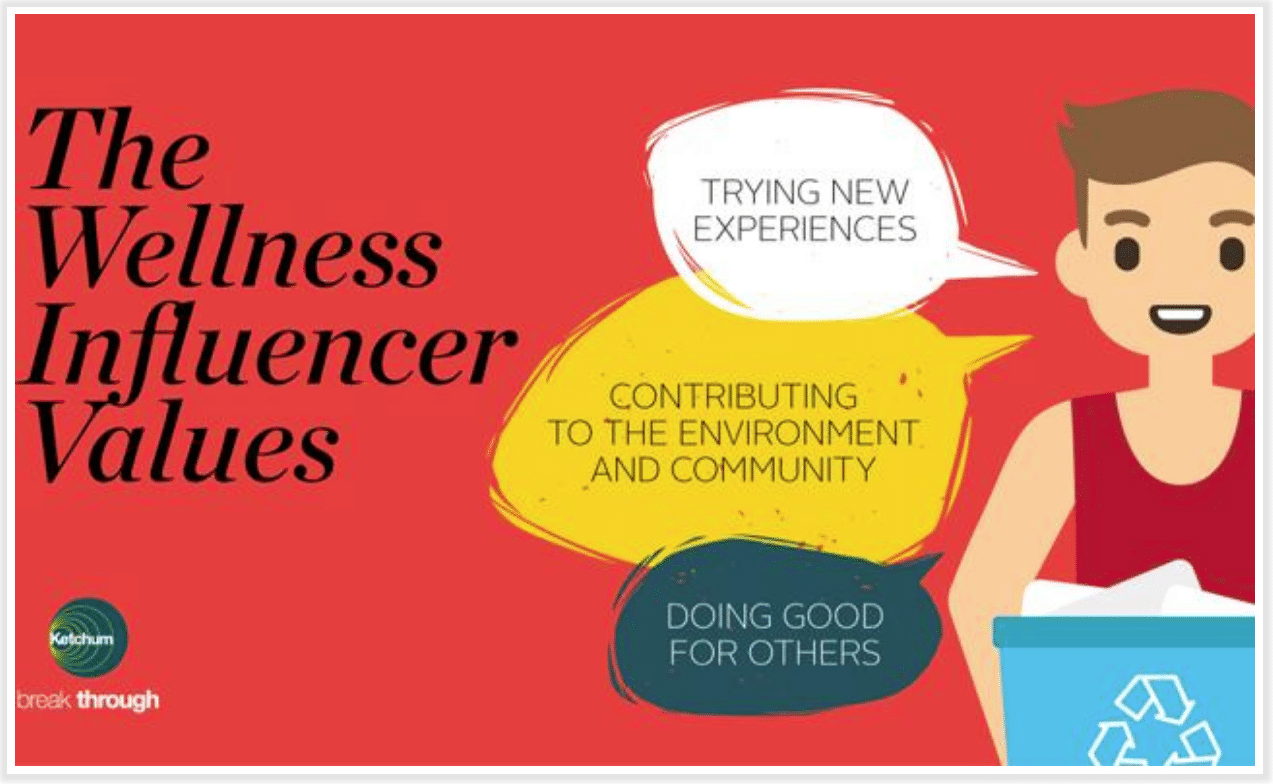With 93 percent of Americans reporting they have at least one wellness goal, there is growing evidence that the wellness movement is impacting almost everyone—and overturning old stereotypes.
A new study by global communications firm Ketchum shows that the definition of wellness is equally emotional as it is physical, and that today’s wellness influencer is most commonly young, male, and ranks mindfulness and positive relationships among his top goals for well-being.
“This is not your mom’s wellness—wellness is not the same as health. It’s now an intentional pursuit of spiritual, emotional as well as physical well-being, and young adults are the ones who are influencing its evolution,” said Christy Salcido, SVP and director of the Ketchum West Brand Practice, in a news release.
Ketchum’s new Influence of Wellness study, surveying 1,046 American adults, illustrates numerous ways that the wellness movement is evolving:
- Emotional aspects (71 percent) are considered equally as important as physical (72 percent) when consumers rank the six dimensions of wellness defined by the National Wellness Institute (emotional, intellectual, occupational, physical, social and spiritual).
- Men are slightly more likely than women to rate social aspects as important (30 percent vs. 27 percent for women) and less likely to rate physical aspects (68 percent vs. 75 percent for women).
- Both men and women equally experience such wellness barriers as putting others first (men 22 percent, women 25 percent) and lack of support from a spouse or partner (men 5 percent, women 5 percent).
- Young adults are less skeptical than their elders: 80 percent of those age 55 and over think wellness brands exaggerate the benefits of their products or services, compared to 64 percent of 18- to 24-year-olds.
Meet the Wellness Influencer
As part of this study, Ketchum identified a subset of the survey population—the Wellness Influencers—who share their opinions about wellness and about wellness purchase habits with friends and/or family, recommend or critique a wellness brand, and follow a wellness critic, blogger or journalist online as well as posting comments on their content.
“Today’s Wellness Influencer defies the stereotype that wellness is the purview of women or boomers,” said Salcido. “Ketchum’s data shows that the Wellness Influencer tends to be young, male and more likely than the average consumer to pursue mindfulness and positive relationships as goals.”
Other traits that set Wellness Influencers apart from the typical consumer:
- They place more importance on doing good for others and on social factors, such as how they contribute to the environment, community, and in-person social networks.
- They place above-average importance on trying new experiences.
- Not only are they more likely to influence others, these individuals are far more likely to be influenced by their family, friends, spouse/partner and medical professionals.
- They are also more likely to be influenced by social media celebrities (such as Instagrammers or bloggers) or traditional celebrities such as actors, athletes or musicians.
Rich opportunities for wellness brands
The wellness industry, estimated at $3.72 trillion by the Global Wellness Institute, offers significant opportunities for brands. According to Ketchum’s survey, consumers view wellness very positively: three-quarters believe that achieving wellness is now as valuable as achieving financial stability, and 66 percent would choose products or services with embedded health benefits over those without.
However, 77 percent also believe that wellness brands exaggerate the benefits of their products and services, while just over half (52 percent) believe wellness brands don’t do a good job describing how their products can improve wellness. More than 3 in 4 (77 percent) report personal barriers to wellness, choosing the following among their top two: temptation (33 percent), sticking with it (27 percent), affordability (24 percent), putting others first (23 percent), lack of time (19 percent) and not knowing where to start (18 percent).
According to Salcido, “This data shows that there is not only purchase preference among consumers, but there is an unmet need for brands that act and speak with transparency and authenticity and explain how their products’ wellness benefits more effectively. Brands also have the opportunity to help consumers remove barriers to wellness.”
Recognizing the tremendous opportunity for companies in this industry, Ketchum is launching a new specialty offering to support wellness brands that draws on its deep category expertise in consumer packaged goods, health, food and beverage, influencer marketing, experiential marketing and analytics. Services tailored to this industry sector, to both start-ups and mainstream companies, include a “Be the Authentic Brand” discovery session and a “Get to Know Your Wellness Influencer” analysis and mapping.
“Our passion for sharing the gift of pure essential oils with millions of people around the world has played a critical role in raising brand awareness and driving growth for our company,” said Andrea Neipp, vice president of Global Brand Awareness for Young Living Essential Oils, in the release. “At Young Living, we are committed to empowering individuals to whole-life wellness in their daily lives.” Together with Ketchum, the company won a PRSA Silver Anvil for an essential oil-infused pop-up installation on New York’s Fifth Avenue that gave busy holiday shoppers a quiet moment to re-center in a uniquely peaceful space.
Influence of Wellness is an eight-question online survey conducted among 1,046 adults in the U.S., including those identified as “Wellness Influencers,” weighted to ensure national representation across gender, age, region, education, income, race and ethnicity. Wellness Influencers were identified as those who are highly engaged with wellness content online, including sharing opinions, recommending brands and following industry stakeholders. The survey was conducted March 13 to 14, 2018, with a margin of error of +/- 3.07 at the national level with a 95 percent confidence level.









